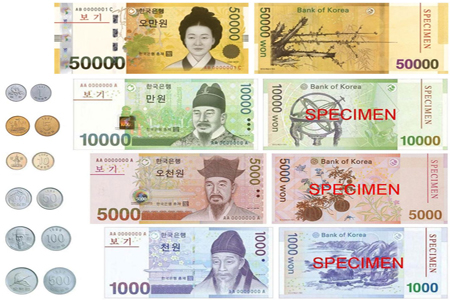No products in the cart.
Korea Travel Information
Korea Currency
Hop on a trip to any country, preparing for local money is always recommended. Before taking a Korea shore excursion, get to know about Korean currency first.
During the period of Korea under Japanese occupation, due to the influence of Japan, Korean yen was considered as the currency of Korea. After World War II (1945), Korea was divided into the South and the North that entailed two distinct currencies including the Southern won and the Northern won. The South Korean won which is subdivided into 100 jeon was introduced by the Bank of Korea as a replacement for the yen. It has been the sole legal tender since March 22nd, 1975. As regards the currency exchange rate, 1 U.S. dollar has equaled to 1,108.647 South Korean won (August 8th, 2016).

Currently, Korea's monetary system consists of 2 types: coin and banknotes in which the coin contains 4 denominations: 10 won, 50 won, 100 won, and 500 won and the banknotes includes 4 denominations: 1,000 won, 5,000 won, 10,000 won, and 50,000won. The description below would provide additional information concerning all coins and banknotes in circulation.
- 10 won coin (18 mm) has Dabotap pagoda stamped on the obverse and its value (digit), the bank title and the year of minting stamped on the reverse.
- 50 won coin (21.6 mm) has a stalk of rice stamped on the obverse and its value (digit), the bank title and the year of minting stamped on the reverse.
- 100 won coin (24 mm) has the portrait of Yi Sun-sin stamped on the obverse and its value (digit), the bank title and the year of minting stamped on the reverse.
- 500 won coin (26.5 mm) has the Red-crowned crane stamped on the obverse and its value (digit), the bank title and the year of minting stamped on the reverse.
- 1,000 won banknote (blue) has the portrait of Yi Hwang, Myeongryundang in Seonggyungwan and plum flowers stamped on the obverse and "Gyesangjeonggeodo" - a painting Yi Hwang in Dosan Seowon by Jeong Seon stamped on the reverse.
- 5,000 won banknote (orange) has the portrait of Yi I, Ojukheon in Gangneung, and black bamboo stamped on the obverse and "Insects and Plants" - a painting of a watermelon and cockscombs by Yi I's mother Shin Saimdang stamped on the reverse.
- 10,000 won banknote (green) has the portrait of Sejong the Great, Irworobongdo, a folding screen for Joseon-era kings, and text from the second chapter of Yongbieocheonga, the first work of literature written in Hangul stamped on the obverse and the globe of Honcheonsigye and Cheonsang Yeolcha Bunyajidoin the background stamped on the reverse.
- 50,000 won banknote (yellow) has the portrait of Shin Saimdang with Chochungdo - A Folding Screen of Embroidered Plants and Insects (South Korean National Treasure No. 595) in the background stamped on the obverse and a bamboo and a plum tree stamped on the reverse.
As regards the currency exchange rate, 1 U.S. dollar has equaled to 1,108.647 South Korean won (August 8th, 2016). When making a shore excursion, if you cannot exchange your money for South Korean won, don’t worry as you may exchange it in many banks at the airport such as Korea Exchange Bank, Shinhan Bank and Woori Bank (Incheon international airport or Gimbo international airport). In addition to U.S. dollar, other popular currencies like Euro, Japanese Yen and Chinese Yuan can be also exchanged for South Korean won. If you want to get the lowest exchange fee, Myeong-dong shopping street is the optimal choice with the best money changers.





